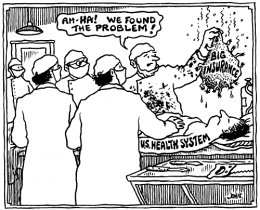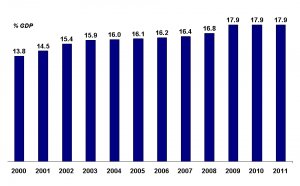
American Health Care System
 The market-based health insurance system in the United States has caused a human legal rights crisis that deprives a large number of folks of the treatment they need. Probably the most noticeable issue is the 32 million individuals without health insurance; many distressing could be the few preventable fatalities - to 101, 000 men and women each year - just because of the method the health treatment system is organized.
The market-based health insurance system in the United States has caused a human legal rights crisis that deprives a large number of folks of the treatment they need. Probably the most noticeable issue is the 32 million individuals without health insurance; many distressing could be the few preventable fatalities - to 101, 000 men and women each year - just because of the method the health treatment system is organized.
This crisis persists despite readily available sources to protect the right to health, record quantities of medical care spending and repeated wellness reform attempts. Since personal determinants, eg battle, earnings and environment, highly influence just who becomes ill and who gets usage of high quality attention, the health care crisis disproportionately impacts disadvantaged teams and under-resourced communities, such as people surviving in impoverishment, individuals of color, and immigrants. Yet obstacles to accessing treatment, the burden of health debt and shortage of primary attention providers affect all people, including people that have employer-sponsored insurance coverage. Overall, the treatment crisis may be the results of the privatization and commodification of the U.S. wellness system, which reflects market imperatives and profit passions that devalue person requirements, self-esteem and equality.
How the U.S. medical care system fails to protect the personal to wellness
Health results:
- The U.S. has a higher baby mortality price and lower life expectancy than similar countries. (WHO 2007, Commonwealth Fund 2007)
- The U.S. has got the highest price of maternal death among high-income nations (13 in 100, 000), plus the greatest price of C-Sections (32percent, as opposed to a which suggested 5-15per cent)
- 45, 000 people perish every year simply because they do not have medical health insurance (American Journal of Public wellness 2009)
Barriers to care:
- Around 50 million individuals do not have health insurance. Over half them are African People in america. (Center for United states Progress 2009)
- Of those who are guaranteed, at least 25 million are underinsured. They often times forgo treatment as a result of high deductibles and co-pays. (Commonwealth Fund 2008)
- 700, 000 households get broke each year just by trying to buy their health attention – while three-quarters of those are guaranteed. (Wellness Matters 2006). In comparison, the five biggest insurance firms made a combined profit of around $12 billion in '09. (division of health insurance and Human Services 2010)
- U.S. has actually less medical practioners and nurses than many other high-income nations. (WHO 2007)
- Hospitals and doctors tend to be disproportionately based in wealthier places. Community hospitals tend to be shutting in areas where they are many needed.
- The U.S. ranks most affordable among high-income nations in its major care infrastructure. Discover a projected shortage of 44, 000 major attention doctors over the following 15 years. (whom, Health Affairs 2008)
Disparities in accessibility care:
The U.S. has a highly stratified system with individual tiers for different kinds of folks getting different quantities of care.
- The rights of individuals of color tend to be violated: e.g., the 10-year success rate for Ebony individuals of people who have cancer is 60% for Whites and 48% for African Us americans. (SEER cancer statistics, also Office of Minority Health)
- The grade of care provided to people of color is normally reduced, including into the remedy for cancer tumors, heart failure, and pneumonia. (department for Healthcare Research and high quality, 2009)
- While immigrants are often healthiest than the typical resident upon arrival in the us, their health tends to decline the longer they stay in the country. (“Unhealthy assimilation", Demography, May 2006)
- Women are more likely than males to forgo required healthcare due to cost-related access barriers. (Commonwealth Fund 2007)
- Women’s directly to non-discrimination is broken through progressively restricting those services just women make use of, reproductive health care.
Read articles on U.S. wellness reform and man legal rights, co-authored by NESRI's Anja Rudiger, posted in Rights-Based methods to Public wellness (including a foreword by Paul search, former UN specialized Rapporteur regarding Human Right to Health).
Share this Post
Related posts
United Regional Health Care System
Just before entering the work search, you need to review and take these United Regional Pledge of Excellence. When you review…
Read MoreUS Health Care System Explained
This brief movie is an essential guide for just about any international students seeking to study or visit america. With…
Read More
















